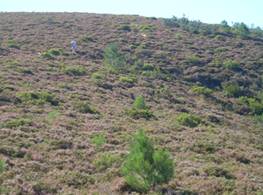Bio-physical description
 |
 |
Existing land use practices
The area is used for goat grazing. The vegetation is composed by shrubs that are burned from time to time by prescribed fire to provide new pasture.
Existing water use practices
In nearby areas used for a primary agriculture, we have the "água de lima", an ancient, gravity flooding irrigation technique.
Existing forest use practices
The area under study is a communal land that was forested in the 1930s - 1940s, and then burned down several times from the 1970s onwards. At the beginning of the 1990, it was transformed in shrub land for grazing and burned down using prescribed fire techniques.
Strengths of existing land use practices
A more conservative land use, used to prevent the progression of forest fires, foster economic and ecological diversity.
Weaknesses of existing land use practices
The major problem in the area is the recurrence of forest fires that destroy everything and produce unsustainable conditions, limiting the land use possibilities, ending up in domination by the shrub species Cistus ladeniferous that is the ultimate degree of degradation.
Major degradation issues due to the use of natural resources
Enhanced soil erosion and loss of soil fertility, over the medium and long term. Biodiversity is doomed to decrease sharply after several consecutive fires.